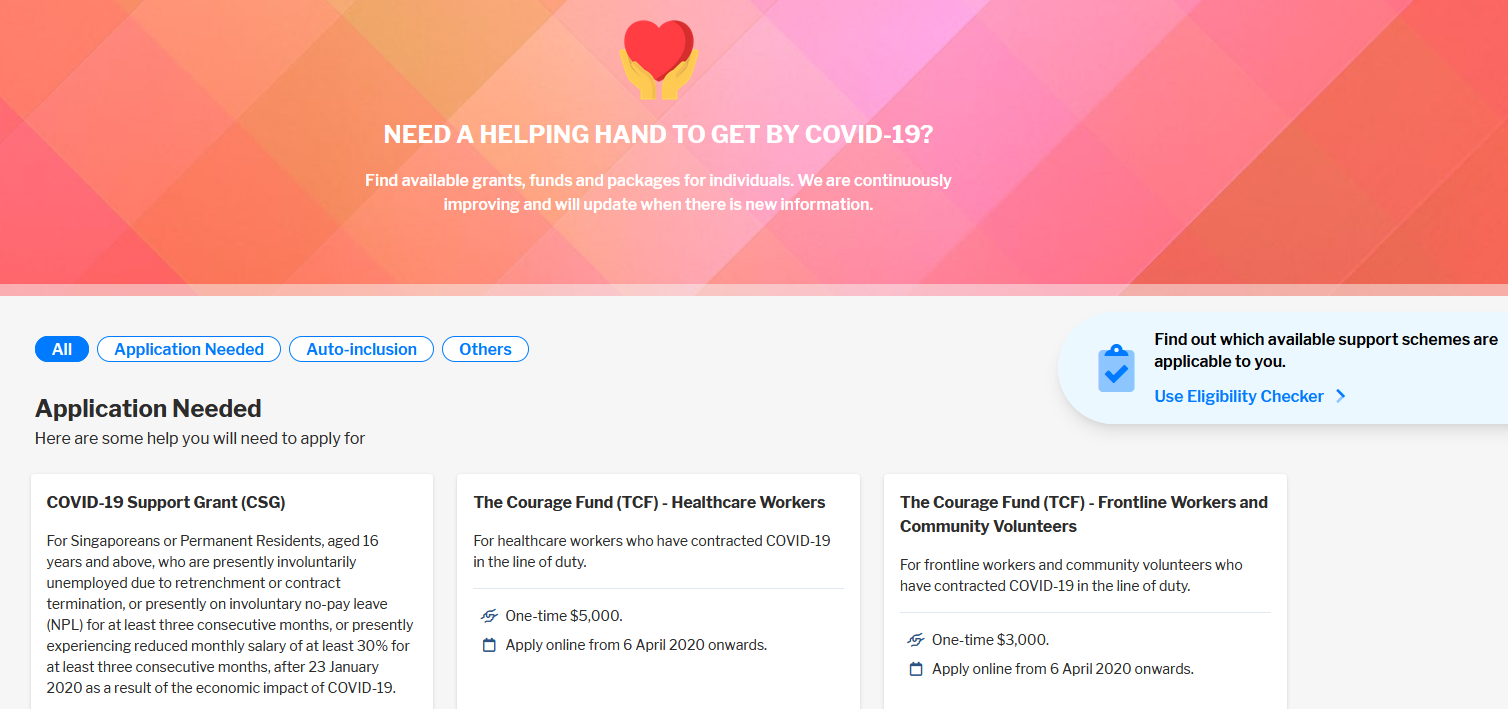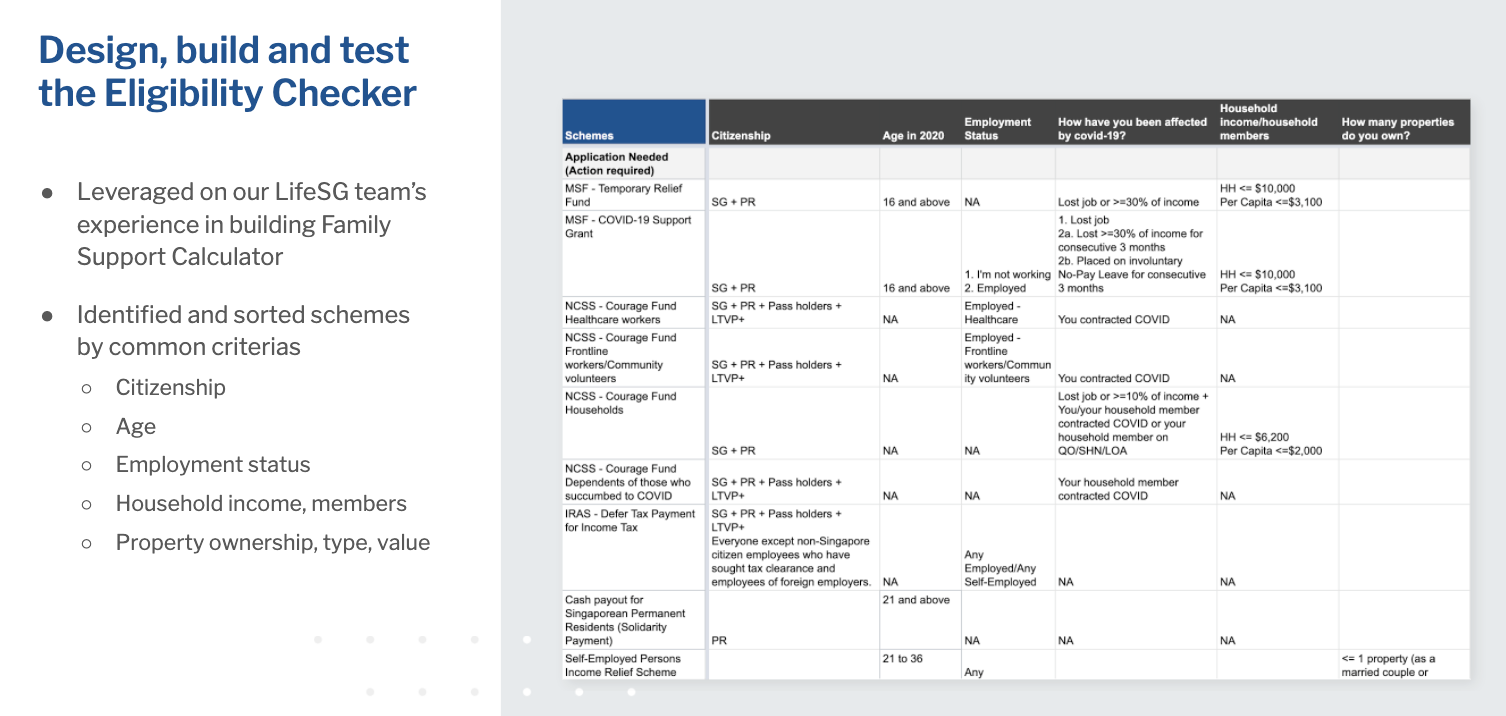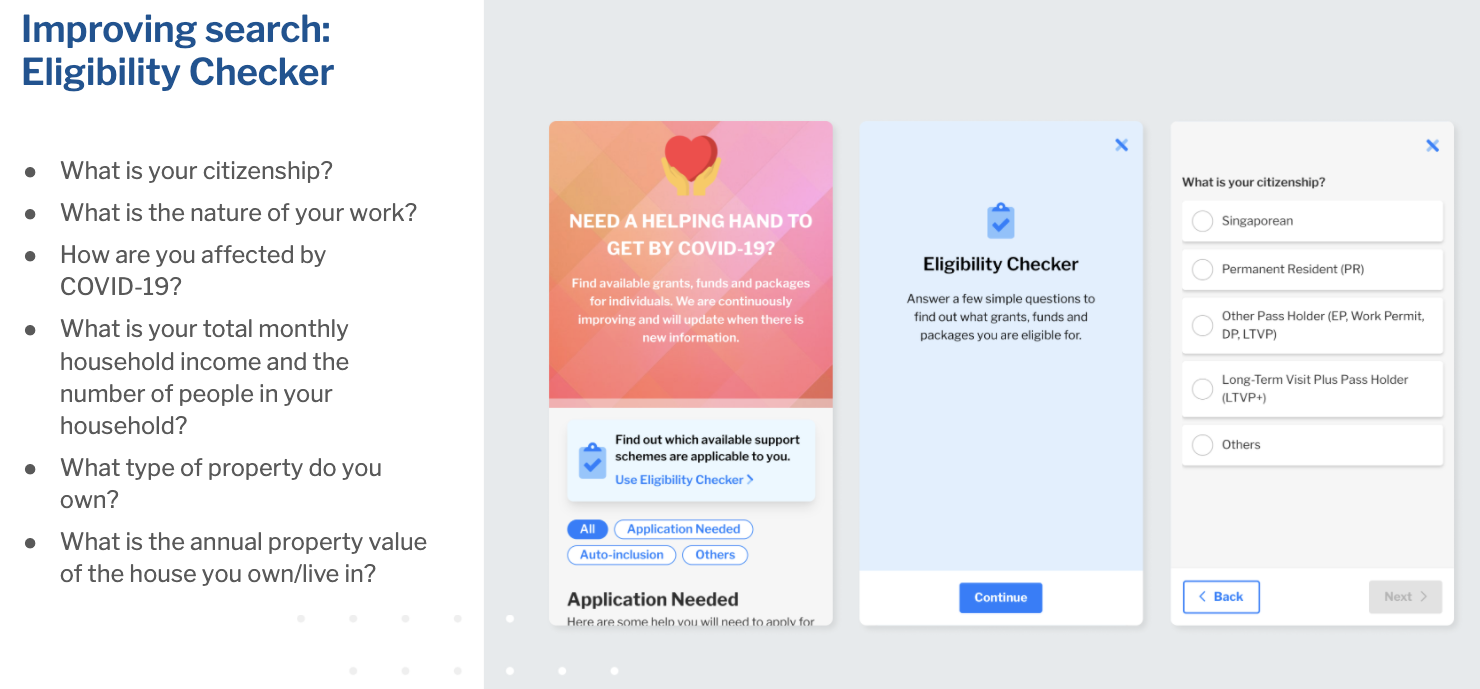STACK-X Webinar – Tech for Public Good: Supporting the Community (Part 2)
The following article was adapted from a STACK-X Webinar conducted by Jeremy Lee, Product Manager, GovTech and Sim Jia Sheng, UX Designer, GovTech.
Part Two focuses on the development journey of the SupportGoWhere team. Read Part One on SupplyAlly here.
Why develop SupportGoWhere?
When the Circuit Breaker began in April, the Government announced new schemes and grants in the Resilience Budget to help Singaporeans in need through this difficult time. We noticed many Singaporeans coming together to share the information on these different grants via social media. Some even created Google Sheets to collate, organise and disseminate this information.
That’s when our team thought, what if we could develop an official, online portal that would allow citizens to discover and understand the different schemes and grants available?
How did we plan and develop SupportGoWhere?
First, we ourselves had to learn about the grants that were available. To do so, we visited gov.sg and reached out to key government organisations driving the provision of schemes and grants, including the Ministry of Social and Family Development (MSF) and the Ministry of Culture, Community and Youth (MCCY). We then gathered and collated the most relevant information, synthesising this into bite-sized chunks that could be then displayed on a portal.
During this planning phase, we also utilised some of our experience from building the MaskGoWhere and FluGoWhere platforms. This was really important since we were trying to rapidly develop a Minimum Viable Product (MVP) for SupportGoWhere. We also added analytics and feedback tools to help us assess not only the site’s technical performance, but more importantly understand whether our users were using the platform easily and whether they found it useful.
When we planned SupportGoWhere, we also made a very conscious decision to simplify navigation by having all the applications within one page, split across three broad categories:
-
Means to find information and begin applying for grants.
-
Auto-inclusion grants that users automatically receive (but can nonetheless read about if they’re curious).
-
Other means of support that users can consider.

SupportGoWhere’s post-launch insights
Within one to one and a half weeks of launching the MVP for SupportGoWhere, we observed a good spike in site traffic which validated the benefits of the portal. Our site analytics allowed us to scale our resources to support incoming traffic.
We also observed that many Singaporeans used their mobile phones to access SupportGoWhere and the various GoWhere websites, reinforcing the realisation that we are indeed a mobile-first society. Mobile-first thinking is therefore crucial for anything we design.
Following SupportGoWhere’s launch, we were fortunate to get a lot of grassroots and word-of-mouth promotion. Various social groups and even some Members of Parliament also picked up on the development of SupportGoWhere and shared it with the rest of Singapore.
What did we learn from user feedback and analytics?
As a product manager, I’ve come to understand that we should always approach the building of any product from the perspective of first finding the right problem to solve. With SupportGoWhere, we saw that there was a demand for it, which is why we stepped into the space and used our experience to create our first MVP before using analytics tools to help validate our idea. It is equally important to have a feedback channel with users to identify areas of improvement.
The site was initially available only in English as we wanted to minimise development time and make the product available as early as possible. However, almost immediately after the launch, we received feedback on the need for multi-language support. As a result, our own team members stepped up and we managed to update the site to support Mandarin, Malay and Tamil as well.
We also received some feedback from some users that they were unable to find further information about specific schemes. Hence, we started a small customer support team to help respond to citizens and provide them with the relevant contact information to follow-up with the relevant agencies.
Customer support is part of the user experience in building digital products, and this has become even more important in a crisis. During the COVID-19 situation, it’s been difficult for citizens to travel down to Social Service Offices to make in-person enquiries, as well as for relatives and friends who wish to support those in need. It was clear to us that every extra bit of support that we could provide in clarifying their doubts and promoting self-service went a long way.
After the first batch of schemes were featured on SupportGoWhere, we received early feedback that some citizens had had their applications rejected. That validated our need to develop an eligibility checker – a feature we considered during the planning phase – that could help guide citizens to schemes which they were eligible for. Post-launch, we immediately started working on the eligibility checker by tapping on the LifeSG team’s previous experience in building the family support calculator on their app.
Featured below are some of the common criteria used to assess eligibility for support schemes and grants:

We designed the eligibility checker with the aim of returning accurate results in as few questions as possible for visitors (based on their demographic or living circumstances). After some testing to ensure that the schemes could be accurately filtered, we updated SupportGoWhere with the eligibility checker, with the finished product below:

From our experience developing this tool, we learnt that filtering accuracy has to be balanced with ease of use, since our objective is to increase the overall conversion rate. With around 20 to 40 support schemes listed on SupportGoWhere at any point in time, it was not practical for us to factor in all the requirements of every individual scheme. Doing so would have required us to design questions that only applied to one or a few schemes, leading to a significantly longer questionnaire and possibly more user frustration.
Through user analytics, we saw that 20% of SupportGoWhere’s visitors used the eligibility checker after we first added it. We also saw a spike in its usage after the schemes introduced under the Fortitude Budget were added to SupportGoWhere in late May. This usage stabilised to 10% after mid-June, likely because there were fewer new schemes displayed on the site. During this period, we also observed a slight increase in return visitors, who were likely more familiar with the schemes by then and hence did not need to rely on the checker.
What would you have done, if you had more time?
I try not to see things from the perspective of “more time” or “less time” because there are always many constraints to consider when developing a product. In fact, given more time, we might not necessarily have designed a better product.
The important thing for us was not just to quickly launch a product, but to create one that could bring benefits to many people. Post-release, we had some breathing room to improve our MVP. Feedback from users helped us identify what kinds of features we could develop to meet citizens’ needs.
Looking ahead, we are continuing to update SupportGoWhere with new support schemes. With every new scheme added, we consider if we need to also update the eligibility checker to take into account the criteria of the newly-onboarded schemes. We are also in discussions with several government agencies to explore if the concept behind SupportGoWhere can be replicated for their own uses, as well as whether it has potential to be expanded beyond the immediate COVID-19 context to cover other forms of government schemes. User research will continue to be crucial in navigating each step of the road ahead.
By Jeremy Lee, Sim Jia Sheng and Shawn Teo
Published on 17 September 2020.
Last updated 17 April 2025
Thanks for letting us know that this page is useful for you!
If you've got a moment, please tell us what we did right so that we can do more of it.
Did this page help you? - No
Thanks for letting us know that this page still needs work to be done.
If you've got a moment, please tell us how we can make this page better.

